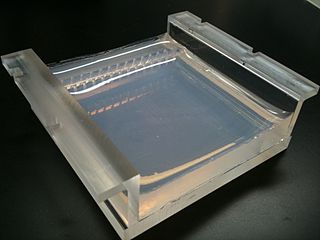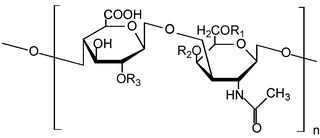Related Research Articles

Agarose is a polysaccharide, generally extracted from certain red seaweed. It is a linear polymer made up of the repeating unit of agarobiose, which is a disaccharide made up of D-galactose and 3,6-anhydro-L-galactopyranose. Agarose is one of the two principal components of agar, and is purified from agar by removing agar's other component, agaropectin.

A transferase is any one of a class of enzymes that catalyse the transfer of specific functional groups from one molecule to another. They are involved in hundreds of different biochemical pathways throughout biology, and are integral to some of life's most important processes.

Glycosaminoglycans (GAGs) or mucopolysaccharides are long linear polysaccharides consisting of repeating disaccharide units. The repeating two-sugar unit consists of a uronic sugar and an amino sugar, with the exception of keratan, where in the place of the uronic sugar it has galactose. Because GAGs are highly polar and attract water, they are used in the body as a lubricant or shock absorber. Mucopolysaccharidoses are a group of metabolic disorders in which abnormal accumulations of glycosaminoglycans occur because of enzyme deficiencies.

Alpha-galactosidase is a glycoside hydrolase enzyme that hydrolyses the terminal alpha-galactosyl moieties from glycolipids and glycoproteins. Glycosidase is an important class of enzyme catalyzing many catabolic processes, including cleaving glycoproteins and glycolipids, and polysaccharides. Specifically, α-GAL catalyzes the removal of the terminal α-galactose from oligosaccharides.

Heparan sulfate (HS) is a linear polysaccharide found in all animal tissues. It occurs as a proteoglycan in which two or three HS chains are attached in close proximity to cell surface or extracellular matrix proteins. It is in this form that HS binds to a variety of protein ligands, including Wnt, and regulates a wide range of biological activities, including developmental processes, angiogenesis, blood coagulation, abolishing detachment activity by GrB, and tumour metastasis. HS has also been shown to serve as cellular receptor for a number of viruses, including the respiratory syncytial virus. One study suggests that cellular heparan sulfate has a role in SARS-CoV-2 Infection, particularly when the virus attaches with ACE2.

Sulfatases EC 3.1.6.- are enzymes of the esterase class that catalyze the hydrolysis of sulfate esters. These may be found on a range of substrates, including steroids, carbohydrates and proteins. Sulfate esters may be formed from various alcohols and amines. In the latter case the resultant N-sulfates can also be termed sulfamates.
In enzymology, a N-acetylgalactosamine-6-sulfatase is an enzyme that catalyzes the chemical reaction of cleaving off the 6-sulfate groups of the N-acetyl-D-galactosamine 6-sulfate units of the macromolecule chondroitin sulfate and, similarly, of the D-galactose 6-sulfate units of the macromolecule keratan sulfate.
In enzymology, a galactose-6-sulfurylase is an enzyme that catalyzes the chemical reaction
In enzymology, a fucosylgalactoside 3-alpha-galactosyltransferase is an enzyme that catalyzes the chemical reaction
In enzymology, a galactinol-sucrose galactosyltransferase is an enzyme that catalyzes the chemical reaction
In enzymology, a galactosylxylosylprotein 3-beta-galactosyltransferase is an enzyme that catalyzes the chemical reaction
In enzymology, a lipopolysaccharide 3-alpha-galactosyltransferase is an enzyme that catalyzes the chemical reaction
In enzymology, a xylosylprotein 4-beta-galactosyltransferase is an enzyme that catalyzes the chemical reaction
Agarase is an enzyme with systematic name agarose 4-glycanohydrolase. It is found in agarolytic bacteria and is the first enzyme in the agar catabolic pathway. It is responsible for allowing them to use agar as their primary source of Carbon and enables their ability to thrive in the ocean.

Carbohydrate sulfotransferases are sulfotransferase enzymes that transfer sulfate to carbohydrate groups in glycoproteins and glycolipids. Carbohydrates are used by cells for a wide range of functions from structural purposes to extracellular communication. Carbohydrates are suitable for such a wide variety of functions due to the diversity in structure generated from monosaccharide composition, glycosidic linkage positions, chain branching, and covalent modification. Possible covalent modifications include acetylation, methylation, phosphorylation, and sulfation. Sulfation, performed by carbohydrate sulfotransferases, generates carbohydrate sulfate esters. These sulfate esters are only located extracellularly, whether through excretion into the extracellular matrix (ECM) or by presentation on the cell surface. As extracellular compounds, sulfated carbohydrates are mediators of intercellular communication, cellular adhesion, and ECM maintenance.

Butylphthalide is one of the chemical constituents in celery oil, along with sedanolide, which is primarily responsible for the aroma and taste of celery.
Iota-carrageenase is an enzyme with systematic name iota-carrageenan 4-beta-D-glycanohydrolase (configuration-inverting). This enzyme catalyses the following chemical reaction
Beta porphyranase is an enzyme responsible for the degradation of porphyran, which composes the cell wall of red algae. So far only five β-porphyranases have been identified: PorA and PorB are found in the marine bacteria Zobellia galactinovirans. A wild-type porphyranase activity has been found in Pseudoalteromonas atlantica. BpGH16B and BpGH86A have been found in the human gut bactrium, Bacteroides plebeius, of Japanese individuals.
Alpha-gal allergy — or mammalian meat allergy (MMA) — is a type of meat allergy characterized by a delayed onset of symptoms after ingesting mammalian meat and resulting from past exposure to tick bites. It was first reported in 2002. Symptoms of the allergy include rash, hives, nausea or vomiting, difficulty breathing, drop in blood pressure, dizziness or faintness and severe stomach pain.
Bacteroides plebeius is a microbe found in the human gut, most often found in Japan natives. The microbe is believed to have obtained the gene for degradation of porphyran via horizontal gene transfer. The porphyranase encoding gene is believed to have been derived from the microbe Zobellia galactanivorans. Microbes in the gut are responsible for their production of carbohydrate active enzymes or CAZymes. CAZymes are responsible for a variety of functions involving complex carbohydrates such as synthesis, recognition, or metabolism. Moreover, CAZymes are not encoded in the human genome, highlighting the importance of microbes in digestive processes. B. plebeius contains a gene known as BACPLE_01693 which encodes β-porphyranase-A.
References
- 1 2 3 Rees DA, Conway E (August 1962). "The structure and biosynthesis of porphyran: a comparison of some samples". Biochem. J. 84 (2): 411–6. doi:10.1042/bj0840411. PMC 1243684 . PMID 14490986.
- ↑ Peat S, Turvey JR, Rees DA (August 1961). "Carbohydrates of the red alga, Porphyra umbilicalis". J. Chem. Soc.: 1590–5. doi:10.1039/jr9610001590.
- 1 2 Zhang Q, Li N, Liu X, Zhao Z, Li Z, Xu Z (January 2004). "The structure of a sulfated galactan from Porphyra haitanensis and its in vivo antioxidant activity". Carbohydr. Res. 339 (1): 105–11. doi:10.1016/j.carres.2003.09.015. PMID 14659676.
- 1 2 Zhang Q, Qi H, Zhao T, et al. (October 2005). "Chemical characteristics of a polysaccharide from Porphyra capensis (Rhodophyta)". Carbohydr. Res. 340 (15): 2447–50. doi:10.1016/j.carres.2005.08.009. PMID 16150429.